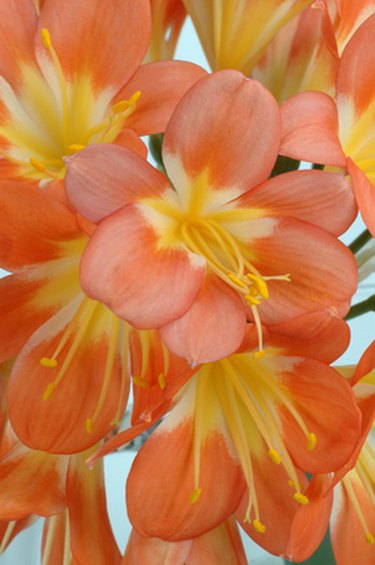Things You'll Need
4 pieces of rot-resistant lumber (2 inches x 6 inches x appropriate lengths for the raised bed)
Galvanized screws
Screwdriver
Level
Clean river sand
Commercial topsoil (optional)
Shovel
Soil testing kit (optional)
Pulverized pine bark mulch

Clivia--scientifically known as Clivia miniata, and also called bush lily, St John's lily, kaffir lily and fire lily--is a tropical perennial plant that features glossy evergreen leaves and brilliant red, orange and gold funnel-shaped blooms that appear from mid-spring to early summer. A relative of the amaryllis, clivia originated in South Africa and thrives outdoors in frost-free areas, such as parts of California and Florida, where temperatures rarely fall below 30 degrees Fahrenheit. Clivia can be started from seeds indoors and then transplanted outside. By following good gardening guidelines for transplanting, you can help your clivia plants flourish in their new location.
Step 1
Prepare a raised bed for your clivia seedlings in a shaded area that gets dappled sun; transplanting your clivia under overhanging trees is a good choice. To make the raised bed, fashion four 2 x 6-inch pieces of rot-resistant lumber into a simple frame in the size you want. Attach the pieces to each other with galvanized screws using a screwdriver. Use a level to make sure your frame is level in all directions. Mix one part washed river sand for every nine parts of commercial topsoil or rich garden soil and add it to the bed. The soil should be at least six inches deep.
Video of the Day
Step 2
Use a soil testing kit, following the manufacturer's instructions, or take a sample to your local county extension office, to determine whether the soil in your bed is at the proper pH for clivia. According to the Shields Garden website, clivia is said to grow best in slightly acidic soil with a pH of 5 to 6. Amend soil according to recommendations.
Step 3
Transplant your clivia seedlings when they are at least six months old; some gardeners wait over a year. Do this in late spring to early summer, the optimal time for transplanting clivia. Dig a hole for each seedling that is slightly bigger than the root-ball and the same depth as the pot. Lightly water the holes and then place the clivia inside.
Step 4
Fill the holes halfway with water, then allow it to drain out. Backfill the rest of the way with garden soil, firming it gently into place. Water the clivia thoroughly.
Step 5
Apply a 1-inch layer of pulverized pine bark mulch to conserve moisture, protect the roots and provide a physical barrier against disease.
Video of the Day